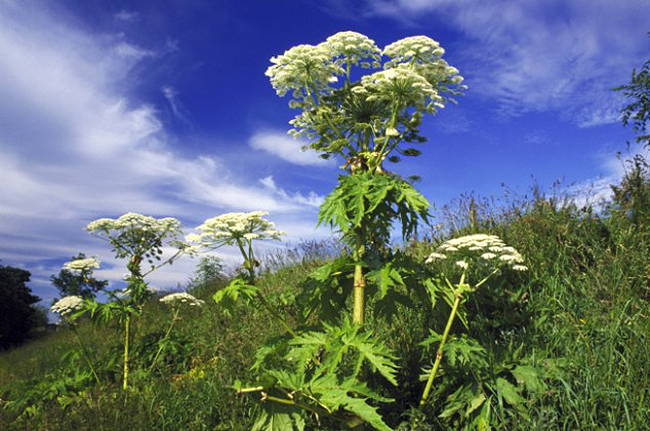Beware The Giant Hogweed Invasion

Over the last week we have seen a dramatic increase in the number of reported cases of injuries sustained from Giant Hogweed. Heracleum mantegazzianum or Giant Hogweed as it is better known was brought to the UK from Central Asia in 1893, and is now a common sight on river banks, canal towpaths and woodland areas but has been spotted in less rural locations with locals in the south reporting sightings of the plant around playgrounds and local supermarkets.
So what do you need to look out for? With long green stems which house clusters of small white flowers it is commonly mistaken for common hogweed, elderflower and bishops lace. To differentiate between these it is the stem that should be inspected (not touched!) as this is the identifying factor in determining what kind of plant you are dealing with. The giant hogweed has a purple hued stem with thin stems and spot covered stalks.
Giant hogweed can grow up to 3.5m (11.5ft) high and can span around 1m (3.5ft). With the flower heads expanding to as much 60cm (2ft) across. Not only is this plant a health hazard to humans its presence is having a negative impact on plant life like other non native invasive plants such as Japanese knotweed and Under The Wildlife and Countryside Act 1981, it is illegal to plant or promote the growth of the plant and landowners must have it removed by specialists if it is found.
How Hogweed Can Hurt You And Your Family
Should you accidently brush up against the Giant Hogweed you may trigger it to release its sap. This sap can cause serious burns within 24hours of contact because the plant contains chemicals that cause photodermatitis. This increases skins sensitivity to sunlight and ultra violet light resulting in blistering, pigmentation and scarring. The blistering can re- occur for many years! Should this sap come into contact with the eyes it can cause temporary or permanent blindness.
If you do come into contact with the plant, experts advise covering up the area of skin immediately to prevent sunlight reaching it - this is the catalyst for the reaction on the skin - then wash the area thoroughly with soap and water. Should you continue to feel unwell contact your GP immediately.

